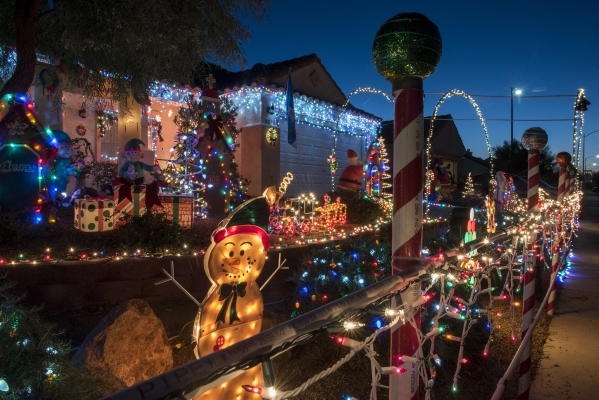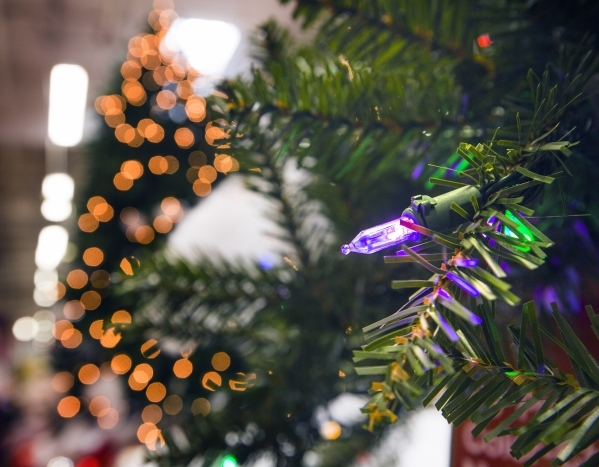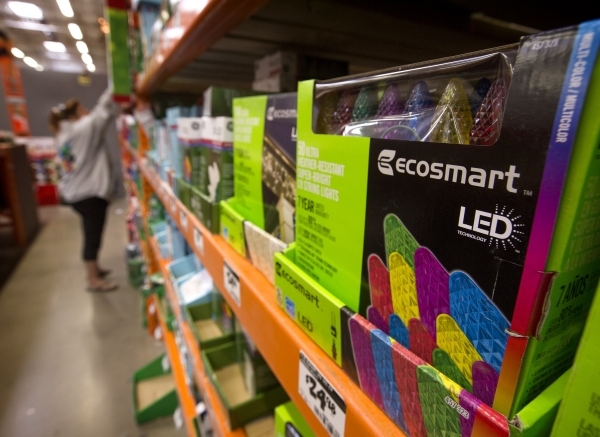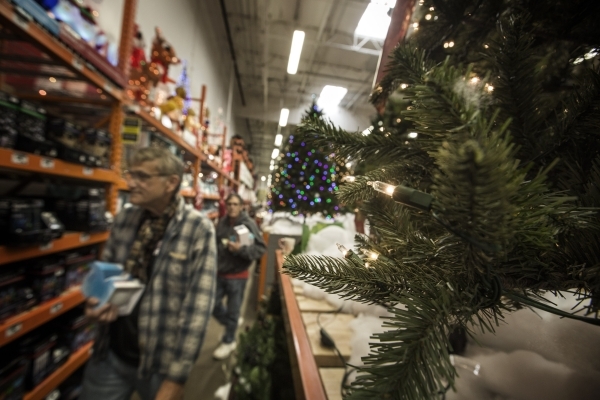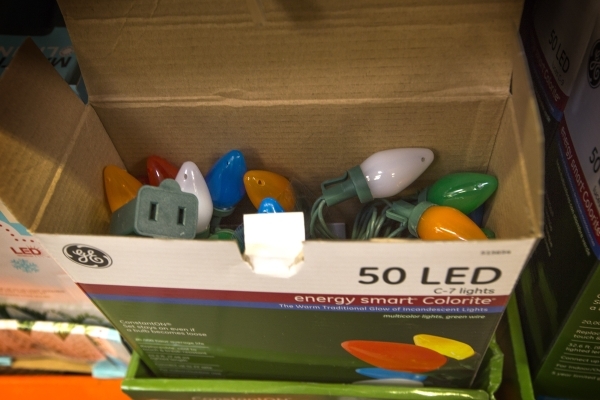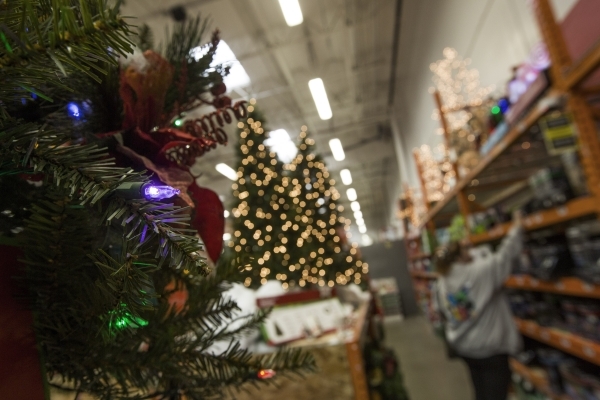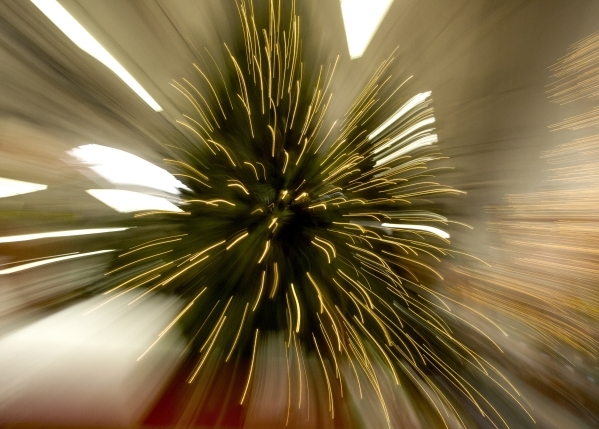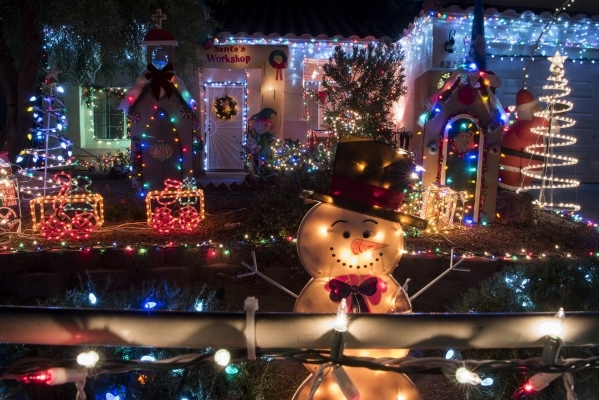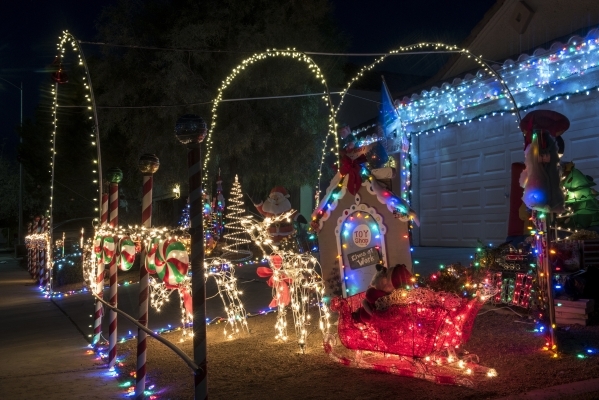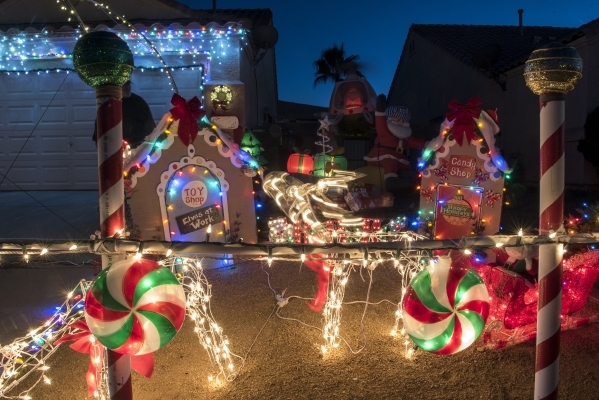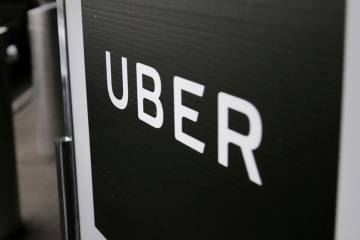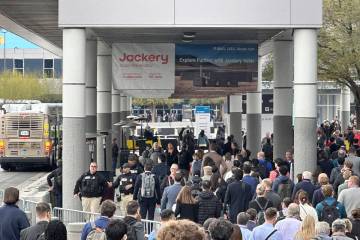How much does it cost to cover your house in Christmas lights?
Hundreds of residential lights will make the holiday season merry and ultrabright in the valley. Henderson's Bob Sacco is adding to the wattage with a 5,000-light display that he began arranging Nov. 1 and built for two weeks.
Sacco, a 61-year-old retired casino chef, and his wife, Peggy, amassed the collection over 15 years. He said its balance has tipped toward energy efficiency; he figures about half his lights are light-emitting diodes. Retailers say LEDs have pushed incandescents to the margins, and a local power official said the more-efficient lights save power and cash for consumers.
No. 1 on NV Energy's Top 10 power-saving holiday tips is to use LEDs, which it said are cooler, last longer and use 90 percent less energy.
That could mean huge savings. A 2008 report prepared for the Energy Department estimated, based on 2007 data, that holiday light use in the United States accounted for 6.63 terawatt hours annually. A terawatt hour is equivalent to 1 billion kilowatt hours.
Kilowatt hours are the standard unit of residential electricity use. One kilowatt hour of energy is equal to 1,000 watt hours and will power a 100-watt incandescent light bulb for 10 hours. One terawatt is a trillion watt hours, which would power that 100-watt incandescent light bulb for 10 billion hours.
NV Energy Senior Program Manager Douglas Eddie said the average Las Vegas Valley household uses 17,400 kilowatt hours a year. So, the annual holiday power used on U.S. holiday lighting would power 381,034 Southern Nevada households for a year.
Switching all holiday lights to LEDs, the Energy Department report said, could save 5.97 terawatt hours annually nationwide. That would be enough to power 343,103 Nevada homes for a year.
The Christmaslightsetc website illustrates just how much power LEDs save. The site said 265 feet (about 88 yards) of strung incandescent lights would use 1,925 watts, require six electrical outlets to connect and cost $52.21 per season to run. The same-length string of LEDs, by contrast, would use 38 watts, require one electric outlet and cost $1.04 a season, the site said.
"LEDs have become much more widely accepted as people have tried them," NV Energy Senior Program Manager Douglas Eddie said. "(Consumers have) been pleased with the light quality … they generate less heat and last substantially longer than incandescent bulbs. Some can last 20 to 25 years, longer than the mortgages on some houses."
And there's safety
Cooler lighting also boosts safety, Eddie added, minimizing the chance of a tree accidentally igniting.
David Cabrera, manager of the Home Depot at 1401 S. Lamb Blvd., said that seven years ago or so, his shop's holiday lights stock was 85 percent incandescents and 15 percent LEDs. That mix has inverted, he said; LEDs are now 85 percent, incandescents 15 percent. Eddie predicted incandescents will vanish from the marketplace in the next two years.
Cabrera said consumers prefer LEDs because they produce brighter, clearer light. White LEDs, for example, lack the yellowish tinge white incandescents do, and hues pop.
"The difference in color is like comparing the picture from an old color TV to the one from a brand-new 1080 (pixel) HD TV," he said.
Both Cabrera and Mike White, assistant manager of the Lowe's at 5825 S. Eastern Ave., say their stores promoted holiday LEDs weeks before Black Friday, putting large bays of the lights in prominent spots. Cabrera said Home Depot from Nov. 9 through Nov. 15 offered a promotion that let customers trade in strings of incandescents for $5 credits to put toward LEDs.
For shoppers, higher prices have been a drawback for LEDs. WeCheckEnergy.com, a Blacksburg, Va., energy auditor, found in a 2011 comparison that a 100-light General Electric LED Christmas light set cost $26.99 while its incandescent analog cost $9.99. Nevertheless, Eddie said, LEDs' longer life spans and lower energy needs make them worth the investment.
Mark Friedgan, chief operating officer and co-founder of Chicago-based Eligo Energy, a technology-focused energy retailer, said digital timers will boost holiday lighting's energy efficiency. These gadgets, many of which include sensors and are operable by smartphone, will make it easier to control how long lights are lit and using energy, he said.
"Even 10 years ago, lighting control systems were luxury items; you'd find them installed only in commercial settings or high-end homes," Friedgan said. "Now you can get consumer-grade systems that are affordable and come without the expensive installation costs and complicated programming."
Energy-use-forecasting websites might quicken the push toward LEDs. Charlotte, N.C.-based Duke Energy, for example, has an online calculator that lets users enter the number of 100-light strands they're using, the type of lights and the hours they will be lit to gauge power use.
Duke Energy spokeswoman Meghan Miles said the calculator has received 10,239 page views since its 2013 launch and 2,900 since October. Hits have come from 49 states and from Canada, England, Scotland, the Philippines and Australia, she said; the site has had seven hits from Nevada since October.
Cash savings
Sacco said his LEDs have saved cash. He said his December power bill is about $230, $70 higher than his November bill. He figured the bill would exceed $300 if all the lights were incandescent.
He's proud of his lights, all 1,000 feet of them; they snake up his archway and cover a miniature handmade house. He has entered the display often in Henderson's annual holiday lighting contest.
His tradition has apparently inspired others.
"I've got my neighbors interested," Sacco said. "Four, five people around me who never decorated before are decorating now."
Find Matthew Crowley on Twitter @copyjockey



